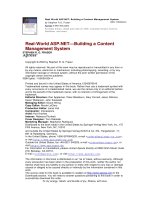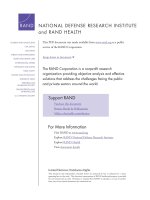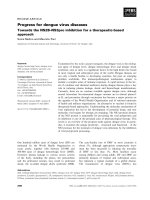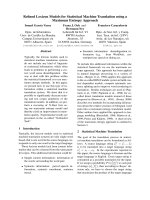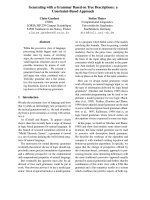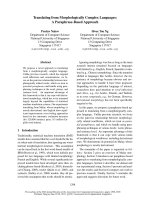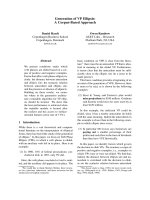Understrength Air Force Officer Career Fields - A Force Management Approach ppt
Bạn đang xem bản rút gọn của tài liệu. Xem và tải ngay bản đầy đủ của tài liệu tại đây (698.18 KB, 115 trang )
This PDF document was made available
from www.rand.org as a public service of
the RAND Corporation.
6
Jump down to document
Visit RAND at www.rand.org
Explore RAND Project AIR FORCE
View document details
This document and trademark(s) contained herein are protected by law
as indicated in a notice appearing later in this work. This electronic
representation of RAND intellectual property is provided for non-
commercial use only. Permission is required from RAND to reproduce, or
reuse in another form, any of our research documents.
Limited Electronic Distribution Rights
For More Information
CHILD POLICY
CIVIL JUSTICE
EDUCATION
ENERGY AND ENVIRONMENT
HEALTH AND HEALTH CARE
INTERNATIONAL AFFAIRS
NATIONAL SECURITY
POPULATION AND AGING
PUBLIC SAFETY
SCIENCE AND TECHNOLOGY
SUBSTANCE ABUSE
TERRORISM AND
HOMELAND SECURITY
TRANSPORTATION AND
INFRASTRUCTURE
The RAND Corporation is a nonprofit
research organization providing
objective analysis and effective
solutions that address the challenges
facing the public and private sectors
around the world.
Purchase this document
Browse Books & Publications
Make a charitable contribution
Support RAND
This product is part of the RAND Corporation monograph series.
RAND monographs present major research findings that address the
challenges facing the public and private sectors. All RAND mono-
graphs undergo rigorous peer review to ensure high standards for
research quality and objectivity.
Lionel A. Galway, Richard J. Buddin, Michael R. Thirtle,
Peter S.H. Ellis, Judith D. Mele
Prepared for the United States Air Force
Approved for public release; distribution unlimited
Understrength
Air Force Officer
Career Fields
A Force Management Approach
The RAND Corporation is a nonprofit research organization providing
objective analysis and effective solutions that address the challenges
facing the public and private sectors around the world. RAND’s
publications do not necessarily reflect the opinions of its research clients
and sponsors.
R
®
is a registered trademark.
© Copyright 2005 RAND Corporation
All rights reserved. No part of this book may be reproduced in any
form by any electronic or mechanical means (including photocopying,
recording, or information storage and retrieval) without permission in
writing from RAND.
Published 2005 by the RAND Corporation
1776 Main Street, P.O. Box 2138, Santa Monica, CA 90407-2138
1200 South Hayes Street, Arlington, VA 22202-5050
201 North Craig Street, Suite 202, Pittsburgh, PA 15213-1516
RAND URL: />To order RAND documents or to obtain additional information, contact
Distribution Services: Telephone: (310) 451-7002;
Fax: (310) 451-6915; Email:
Library of Congress Cataloging-in-Publication Data
Understrength Air Force officer career fields : a force management approach /
Lionel A. Galway [et al.].
p. cm.
Includes bibliographical references.
“MG-131.”
ISBN 0-8330-3699-8 (pbk. : alk. paper)
1. United States. Air Force—Officers. 2. United States. Air Force—Occupational
specialties. 3. United States. Air Force—Personnel management. 4. United States. Air
Force—Job descriptions. I. Galway, Lionel A., 1950–
UG793.U52 2005
358.4'1332'0973—dc22
2004023487
The research reported here was sponsored by the United States Air
Force under contract F49642-01-C-0003. Further information may
be obtained from the Strategic Planning Division, Directorate of
Plans, Hq USAF.
iii
Preface
In the 21st century, the technological complexity of generating and
projecting aerospace power requires a myriad of different skills.
Recruiting, training, and retaining people with the necessary mix of
skills are major challenges for the U.S. Air Force’s personnel commu-
nity. Many career fields have been under strength for several years.
This condition, together with the recent sharp increases in deploy-
ments (especially after the September 2001 attacks), has resulted in
“stressed” career fields: too much work for too few people.
This project, conducted in RAND Project AIR FORCE’s
Manpower, Personnel, and Training program, examines the causes
and some potential cures for understrength conditions in non-rated
line officer career fields, also known as Air Force Specialties (AFSs)
or, colloquially, Air Force Specialty Codes (AFSCs). Based on in-
sights from case studies, we formulate a framework for force man-
agement that will allow understrength conditions to be diagnosed and
resolved.
Understrength Air Force Officer Career Fields: A Force
Management Approach describes the project, “Undermanned AFSCs,”
which was sponsored by the Deputy Chief of Staff for Personnel
(AF/DP). It should be of value to the personnel community in the
Air Force, in other services, and in the Department of Defense.
Comments are welcome and should be sent to the project leader,
Lionel Galway (). Research was completed
in September 2003.
iv Understrength Air Force Officer Career Fields: A Force Management Approach
RAND Project AIR FORCE
RAND Project AIR FORCE (PAF), a division of the RAND
Corporation, is the U.S. Air Force's federally funded research and
development center for studies and analyses. PAF provides the Air
Force with independent analyses of policy alternatives affecting the
development, employment, combat readiness, and support of current
and future aerospace forces. Research is performed in four programs:
Aerospace Force Development; Manpower, Personnel, and Training;
Resource Management; and Strategy and Doctrine.
Additional information about PAF is available on our Web site
at />v
Contents
Preface iii
Figures ix
Tables xi
Summary xiii
Acknowledgments xix
Abbreviations and Acronyms xxi
CHAPTER ONE
Understrength Career Fields 1
Evolution of Project Scope 2
USAF Force Management: A Moving Target 4
Structure of the Report 5
CHAPTER TWO
Defining Understrength Conditions and the Force Management
Framework 7
Diagnosing, Understanding, and Rectifying Understrength Conditions 8
Goal of Force Management 10
Framework for Force Management 11
Tactical 13
Operational 13
Strategic 14
CHAPTER THREE
Understrength Issues for Individual Career Fields: The Case Studies 15
Methodology 15
vi Understrength Air Force Officer Career Fields: A Force Management Approach
Overview of New Officer Assignments 18
Electrical Engineers 24
Understrength Problems 25
Force Management Perspective 31
Acquisition Manager 32
Understrength Problems 34
Force Management Perspective 36
Personnel 37
Understrength Problems 38
Force Management Perspective 42
Communications and Information 42
Understrength Problems 44
Force Management Perspective 47
Intelligence 47
Understrength Problems 48
Force Management Perspective 52
Implications of the Case Studies 53
CHAPTER FOUR
Force Management in the Air Force: Challenges, History, and Current
Initiatives 57
Tactical Success Versus Operational and Strategic Challenges 57
How Has the Air Force Evolved to this Current State? 59
Current USAF Force Management Initiatives 60
Revised Authorization Initiative 60
Air Force Senior Leader Management Office 61
Three Publications on Development 61
Who Will Do Operational-Level Management? 64
CHAPTER FIVE
Conclusions and Recommendations 65
Reinstituting Force Management 66
Doing the Operational Job 66
Doing the Strategic Job 67
Doing the Tactical Job 67
Contents vii
How to Do the Job 68
Operational Level 68
Strategic Level 69
Tactical Level 70
Future Research 71
APPENDIX
Brief Historical Background of Force Management 75
Bibliography 85
ix
Figures
3.1. Non-Rated Operations and Mission Support Career Fields 17
3.2. Commissioning Sources for Non-Rated Line Officers 19
3.3. STP Rates for Second Lieutenants, by Career Field 22
3.4. Prior-Service Content of Recent Second Lieutenants, by
Career Field 23
3.5. Engineering Degrees for Officer Commissioning Classes of
FY1994 Through FY2002 24
3.6. Assignment Patterns in Electrical Engineering 26
3.7. Percentage of Manned Electrical Engineer Duty Assignments,
by Fiscal Year 27
3.8. Loss Rates for Officers, by AFSC 29
3.9. Assignment Patterns in Acquisition Management 34
3.10. Percentage of Manned Acquisition Management Duty
Assignments, by Fiscal Year 35
3.11. Assignment Patterns in Personnel 39
3.12. Percentage of Manned Personnel Duty Assignments,
by Fiscal Year 40
3.13. Assignment Patterns in Communications 44
3.14. Percentage of Manned Communications Duty Assignments,
by Fiscal Year 46
3.15. Assignment Patterns in Intelligence 49
3.16. Percentage of Manned Intelligence Duty Assignments,
by Fiscal Year 51
xi
Tables
3.1. Percentage of College Majors Among Recent Officer Accessions,
by AFSC 21
3.2. Percentage of Second Lieutenants Only Assigned to Key
MAJCOM/Agencies, by AFSC 22
xiii
Summary
Understrength Career Fields (see pp. 1–5)
Generating and projecting aerospace power in the 21st century are
technologically complex, requiring a myriad of different skills.
Recruiting, training, and retaining people with the necessary mix of
skills are major challenges for the U.S. Air Force’s personnel commu-
nity. With the end of the Cold War, the United States armed forces
began to implement a substantial reduction in total personnel, or end
strength. The Air Force, for example, went from a total end strength
of 571,000 in 1989 to 368,000 in 2002, despite the fact that it was
involved in numerous crisis deployments, including major operations
to liberate Kuwait, stop Serbian operations in Kosovo, and after 9/11,
pursue parts of the war on terror in Afghanistan and Iraq. All of these
events left the Air Force with severe manpower problems at the
beginning of the 21st century. Many career fields were understrength:
Authorizations went unfilled, and many fields had severe skill
imbalances, such as a dearth of middle-level people.
This study’s original charter was to examine career fields that
have been “chronically and critically” under strength over time, and
to look for root causes and potential solutions. We initially pursued a
case-study approach, focusing on five varied career fields from the set
of non-rated line officers, also known as Air Force Specialties (AFSs),
or Air Force Specialty Codes (AFSCs). We found that the details of
those problems and potential solutions were widely known to the
managers. However, the managers had little or no access to relevant
policy levers, such as accession and retention policies, which are the
xiv Understrength Air Force Officer Career Fields: A Force Management Approach
basic components of force management. This systemic disconnect in
force management lies at the root of many of the current
understrength problems. Accordingly, after consultation with our
sponsor, we reoriented the project to develop an overall framework
for force management that would identify roles and organizations
that could provide analysis and diagnosis of understrength conditions
and could also execute appropriate policy interventions to solve the
problems.
The Force Management Framework (see pp. 7–14)
The Air Force needs a workforce with a balanced skill and experience
mix; maintaining such a workforce that meets Department of
Defense (DoD) and economic—i.e., budget—constraints requires
that determination of personnel requirements, accessions, retention,
education and training, assignments, and promotions be managed
closely and attentively. Further, such management must be per-
formed at three different levels (which we denote by the familiar mili-
tary terms of tactical, operational, and strategic):
• Tactical: the assignments of individual officers and their indi-
vidual careers.
• Operational: individual career fields (or a set of closely related
fields).
• Strategic: the total Air Force workforce, including overall force
size, officer/enlisted and component mix (i.e., active, Guard,
Reserve, civil service, contractor), and the balance between indi-
vidual career fields.
Understrength Issues for Individual Career Fields (see
pp. 15–55)
The case-study career fields for our detailed analysis were electrical
engineering, acquisition, personnel, communication-information sys-
Summary xv
tems, and intelligence. Our research (our own data analysis for the
case studies, review of previous Air Force work, and discussions with
managers both of the selected career fields and of the Air Force
workforce as a whole) revealed chronic manning problems: For ex-
ample, the Air Force has attracted enough lieutenants to meet end-
strength requirements, but severe problems exist in meeting experi-
ence requirements in many occupations (e.g., in many career fields
there are too few middle-level people). The problem is that most
career-field management activities concentrate on decisions for
tactical problems. These short-term problems are formidable and
leave little time for managing longer-term operational and strategic
issues reflecting a career field’s health.
Force Management in the Air Force: Challenges, History,
Current Initiatives (see pp. 57–64)
We argue that the root of understrength problems is gaps in force
management, particularly at the operational and strategic levels.
Operational-level force management is the key to force management
as a whole. It provides both the policy framework that guides tactical-
level management and the basic informational input for strategic-level
decisions. Strategic-level management transcends operational man-
agement to allocate resources among career fields, possibly changing
their structure and function.
Currently, the Air Force is oriented toward tactical activities be-
cause of the continuous near-term pressures to fill empty positions,
coupled with an organizational structure that tends to emphasize a
decentralized approach toward achieving objectives. The force draw-
down of the 1990s has only exacerbated this phenomenon by reduc-
ing the number of people available to do force management at any
level.
xvi Understrength Air Force Officer Career Fields: A Force Management Approach
Conclusions and Recommendations (see pp. 65–73)
While the lack of force management does not cause all of the Air
Force’s understrength problems (such as competition from private-
sector firms that drain away experienced people), it does inhibit diag-
nosis of problems and the formulation of effective responses to those
problems across the service.
Doing the Operational Job
Operational-level force management, the management of career fields
or career-field families, requires two distinct skill sets: substantive
knowledge of the career field and knowledge of how to manage a dy-
namic, closed, hierarchical personnel system. The latter management
skill, generic across career fields, is generally missing in operational-
level management. We recommend
• making the career field manager (CFM) a full-time position
(currently it is usually part-time
1
), and putting a senior func-
tional officer in the position.
• providing the CFMs with dedicated and standardized analytic
support.
Doing the Strategic Job
The strategic management job is the most difficult and important for
the long-term health of the force. Essentially the locus where re-
sources are allocated so that the Air Force has the balanced force it
needs, this job sometimes requires making explicit decisions about
which career fields get such resources as bonus payments, requiring
making trade-offs among career fields and accepting those trade-offs.
Our recommendations are to
• establish strategic-level personnel decisionmaking in a senior
body with authority to make decisions for the Air Force.
____________
1
As of this writing, late 2003.
Summary xvii
• provide the strategic-level decisionmaking body with a full-time
staff, including access to analytic support that is integrated with
the analytic support provided for operational management.
Doing the Tactical Job
One half of tactical-level management already has a good process in
place in the Air Force: the process of assigning officers to their next
job. The other half is defining longer-term career goals and plans for
individual officers, which has received less consistent attention (al-
though, with the introduction of development teams to review each
officer’s records regularly, it has become the focus of current changes
in Air Force personnel management). We recommend that the Air
Force
• provide the development teams and assignment teams with clear
operational- and strategic-level guidance for managing individ-
ual careers and making assignments.
xix
Acknowledgments
Working on a problem as broad as this required the help of many
parts of the Air Force personnel community. We have attempted to
make the list below as complete as possible, and we apologize in ad-
vance if we have missed anyone. The ranks, positions, and organiza-
tions of people are those as of our discussions with them during our
project (mostly in FY2003).
We owe particular thanks to our action officers at the office of
the Air Force Deputy Chief of Staff for Personnel (AF/DP): Mr.
David Mulgrew (AF/DPLF) and Col Nancy Weaver (AF/DPLT).
At the Air Force Personnel Center (AFPC) at Randolph AFB,
Texas, we thank the following: Col Michael Schiefer (DPS); Col
Nellie Riley (DPAS) and her staff, particularly LtCol Tony Amadeo,
Maj Thomas Layne, and LtCol Jeff Gatcomb; LtCol John Taylor and
staff (DPAOO); LtCol Kenneth Gaines and Maj Robert Berger
(DPASC); and last (but certainly not least), Dr. Jerry Ball and LtCol
John Crown (DPSA). In addition, we had very helpful interviews
with Mr. Vaughan Blackstone (DPAPP) and Mr. Dennis Miller
(DPPAO). Also at Randolph, we were briefed on the responsibilities
and methodologies of the Air Force Manpower & Innovation Agency
(AFMIA) by LtCol Doug Carroll.
On the Air Staff, we thank Col Steve Wagoner (AF/DPXP); Col
Craig Kimberlin and LtCol Mark Hays in the office of the Secretary
of the Air Staff (SAF)/AQRE; LtCol Raymond Harwood, Maj Gary
Leong, and Maj David Morgan in SAF/AQXD; Col John Hesterman
(Air Force Senior Leader Management Office); Ms. Christal Ayo, Ms.
xx Understrength Air Force Officer Career Fields: A Force Management Approach
Genie Catchings, Maj Tony Veerkamp, Maj Steve Forsythe, and
Capt Mike Anderson (Air Force Personnel Operations Agency); Maj
David Cloe and LtCol Peter Read (AF/XOI); LtCol Sheron Bellizan
(AF/ILCX) and LtCol John Clarke (AF/XI); and LtCol Dan Fogarty
(AF/DPLFC).
We greatly appreciated advice during our research from the fol-
lowing RAND colleagues (in alphabetical order): Ray Conley, Gary
Massey, Craig Moore, Al Robbert, and Mike Schiefer.
Finally, we appreciate the thoughtful and painstaking RAND
internal technical review by Ron Sortor and Harry Thie. RAND re-
search communicator Jennifer Li also provided valuable insights on
organization. In addition, the following people sent in thoughtful
comments and suggestions on the original draft: Maj Gen Peter
Sutton and his staff in AF/DPL; Mr. James Barone, Air Force
Materiel Command (AFMC)/DP; and LTC John Taylor at
AFPC/DPAOO.
As always, any remaining errors are the sole responsibility of the
authors.
xxi
Abbreviations and Acronyms
ACC Air Combat Command
ACE Aerospace Communications and
Information Expertise
ACOT Advanced Communications and
Information Officer Training
ADSC Active Duty Service Commitment
AEF Air Expeditionary Force
AETC Air Education and Training Command
AF/DP Air Force Deputy Chief of Staff for
Personnel
AF/ILC Air Force Deputy Chief of Staff for
Installations and Logistics, Directorate of
Communications Operations
AF/XI Air Force Deputy Chief of Staff for
Warfighting Integration
AFAS Air Force Assignment System
AFB Air Force Base
AFI Air Force Instruction
AFIT Air Force Institute of Technology
AFMAN Air Force Manual
AFMC Air Force Materiel Command
xxii Understrength Air Force Officer Career Fields: A Force Management Approach
AFMIA Air Force Manpower & Innovation
Agency
AFOATS Air Force Officer and Accession Training
School
AFPC Air Force Personnel Center
AFPC/DPAS Air Force Personnel Center/Mission
Support Officer Assignments, Directorate
of Assignments
AFPC/DPSA Air Force Personnel Center/Plans,
Analysis, and Information Delivery
Division, Directorate of Operations
AFPOA Air Force Personnel Operations Agency
AFS Air Force Specialty
AFSC Air Force Specialty Code
AFSLMO Air Force Senior Leader Management
Office
AFSPC Air Force Space Command
AIA Air Intelligence Agency
AIPB/PBA aerospace intelligence preparation of the
battlespace/predictive battlespace analysis
ALEET Acquisition and Logistics Experience
Exchange Tour
AMS Assignment Management System
AO Assignment Officer
AOC Air Operations Center
APDC Acquisition Professional Development
Council
ASBC Air and Space Basic Course
AV Audio-visual
BCOT Basic Communications and Information
Officer Training
BPOC Basic Personnel Officer Course
Abbreviations and Acronyms xxiii
C4ISR command, control, communications, and
computers; intelligence, surveillance, and
reconnaissance
CFM career field manager
CGO company-grade officer
CMDB Consolidated Manpower Data Base
CSAF Chief of Staff of the Air Force
CSS Computer System Squadron
DAU Defense Acquisition Univrsity
DAWIA Defense Acquisition Workforce
Improvement Act
DoD Department of Defense
DOPMA Defense Officer Personnel Management
Act
DRU Direct Reporting Unit
DT development team
EBB electronic bulletin board
EE Electrical engineering
FDC Force Development Council
FDO Force Development Office
FDSO Force Development Support Office
FGO Field Grade Officer
FOA Field Operating Agency
GO General Officer
ISR intelligence, surveillance, and
reconnaissance
IT Information Technology
MAJCOM Major Command
MANPER Manpower and Personnel
MC&G Mapping, Charting, and Geodesy
